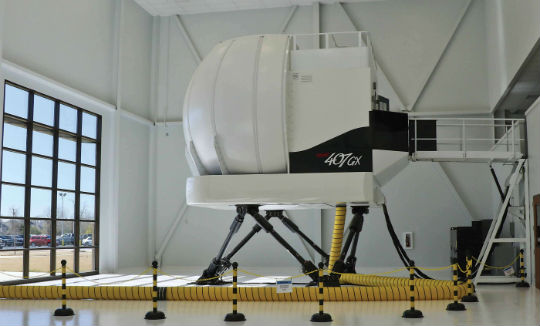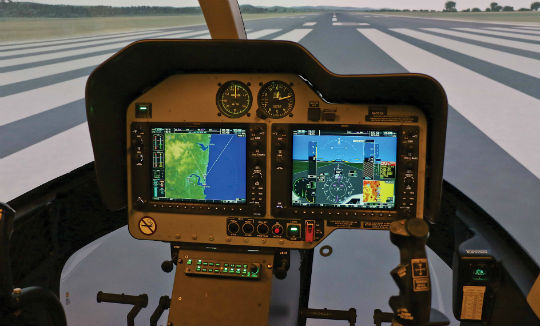
During my visit to the Bell Helicopter Training Academy (BTA) in Fort Worth, Texas, I had the opportunity to fly its new Frasca Bell 407GX full flight simulator (FFS). My session followed two days of 407 recurrent training, which gave me a great baseline for the evaluation.
My instructor for the sim session was Scott Chachere. We began with a briefing on the objectives of my one-hour session and then we proceeded to the sim, where Chachere sat upfront with me. He had a wireless tablet with him that allowed him to perform any function he desired — just as if he were sitting at the full instructor’s station behind the pilot.
I enjoyed having him up front. He could point out noteworthy items in the FFS, quickly jump in if I asked for a demonstration, and yet still wreak havoc with me on the multitude of failures that sadistic instructors all seem to enjoy.
Chachere pulled out the checklist and told me to go through the start-up process. Having flown the actual 407GX, as well as a number of fixed-wing aircraft with the Garmin G1000, the system wasn’t strange to me. (Of note, the G1000 in the FFS is a real unit — it is fed information by a Bell 407 data loader specially modified for the FFS.)
The panel in the FFS can be swapped out with an analog panel if desired. However, the 407GX customers have priority. So as long as the schedule stays busy with GX customers, the analog 407 pilots will continue to use the 407 flight training device (FTD).
As we progressed through the start-up process, the default pilot profile was selected, and then we played a bit with the weight and balance page. Although my primary interest was to compare how the FFS flew to the actual 407, it was still appropriate that Chachere take me through some of the G1000 functions he thought I’d find interesting. After all, the benefit of this sim is not just the full motion, but to integrate appropriate G1000 system functions into each training period.
Following that play time, and with the systems page occupying the full screen of the Multi-Function Display (MFD), it was time for engine start. Once I initiated the start and confirmed it wasn’t going to go hot, my glance up towards the rotor yielded the same result as in the aircraft — the rotors were turning. The rest of the systems checks were completed and it was time to fly.
Taking the sim for a spin
As in most sims, the sitting position on the ground was a little higher than the actual aircraft, but it was not near as obvious in this FFS. When I picked up to a hover, it swayed a little left and right until I was able to settle it down. With the motion, it had a very minimal “mushy” feel to it at first, but it came to me quickly and the first normal takeoff went quite well.
Having just completed a two-day 407 (analog) recurrent training course, I had the advantage of being fresh in the aircraft. And it spoke highly to the accuracy of this FFS that I was able to quickly transfer the control touch of the aircraft to the sim and get the same results.
During the initial climb out, I had my first chance to relax and take in the high quality of the visuals. The graphics are very clean and highly detailed. The sim had an Oregon location; when we hovered over a field, you could see the blades of grass leaning over through the chin bubble.
Chachere pointed out that the visual stimulus is favored on the side of the student. So, in my case, flying from the right seat the visuals are at their best. For Chachere sitting in the left seat, his visuals are degraded from the level of the customer view. But I never would have known it based on the precision of his demonstrations, and from what I saw from my seat. Also, if the training customer is in the left seat for whatever reason, the higher quality customer view visuals can be switched to that side.

One of the tasks I wanted to try was an instrument landing system (ILS) approach incorporating the pathway in the sky feature. Chachere grabbed his tablet and changed the weather to an instrument meteorological conditions (IMC) environment. He set up the approach for me and I flew it as instructed. The simple truth is it was so easy to fly the system it felt like I was cheating.
One disappointment, however, is that the FFS did not have any autopilot such as the Genesys HeliSAS. (The Frasca Level 7 407 FTD at Metro Aviation, and Level 7 Bell 206 FTD at Air Evac both include the HeliSAS system.) These units are becoming much more commonplace and getting some practical training in the sim on the system before trying it in the aircraft would be quite beneficial — especially in training for inadvertent IMC recovery procedures.
Impressive autorotation performance
Back into visual flying, I made my first approach, which was a normal one to a hover. The sim was a little more sensitive than the actual 407, but this was easy enough to overcome by simply doing nothing, instead of chasing every little motion with the cyclic.
I did some hover work — something many sims are frustratingly bad at allowing you to perform. But this sim was smooth, and I had no problem doing pedal turns and other normal hover maneuvers. It’s certainly clear how new technology has allowed simulator companies like Frasca to develop sims that fly more and more like the aircraft they emulate. And this fact — for me — stood out the most when I performed an autorotation.
As mentioned above, this sim session followed two flight periods in the actual 407 that included a slew of touchdown autos. So when Chachere grabbed his tablet and failed the engine, I did exactly what Bell instructor, Chuck Cook, and I had been doing in the actual 407, and the sim responded in kind.
At the initial failure the MFD immediately reverted to the engine page, and even the slightest variations in rotor RPM could be heard. But flying the auto felt very natural. The pitch attitude for the target speed seemed just a little more nose-up than the real 407, but it really wasn’t an issue and both speed and rotor RPM control were very natural.
Because the sim sits just a bit higher on the round than the real 407, I took a guess at where to flare — which was a little higher than I would normally have flared. As it turned out, I could have let it go just a little lower and as such, my touchdown was a bit more firm than it needed to be and ended with a short slide — scraping skid noise and all. It was still quite gratifying.
We finished off the session with some stuck pedal scenarios at my request. It came as no surprise how beneficial the sim was in working through those emergency procedures in the safety of a box instead of the airframe.
The 407GX sim was a big leap of faith for the BTA. “The Bell 407 is a well-selling platform so the cost/benefit was there to develop the sim,” said Ray Lamas, BTA general manager of global customer training. “It’s certified to Level B right now due to lower developmental costs and to test the market, but it can be upgraded to Level D if the demand calls for it.”
With ever advancing technologies improving the realism and effectiveness of simulators while also reducing relative costs, it’s no wonder why simulators — especially those with full motion or high level motion cueing — are becoming more integrated into type-specific flight training programs. The BTA is just one example of how OEMs as well as larger helicopter operators are taking their simulator training programs beyond the basic FTD.






Buenos dias la presente es con el fin de solitar su colaboracion con una cotizacion del simualdor bell ranger 407 con sistema de movimiento y sisn sistema de movimineto.
quedo atento a su respuesta
cel 3502814255